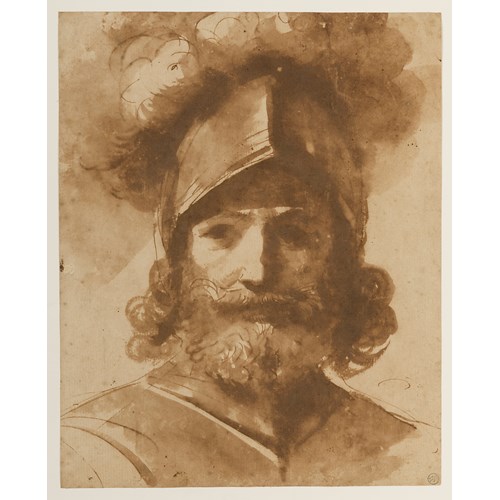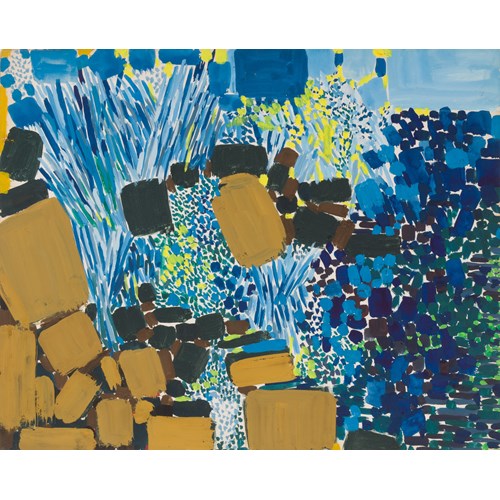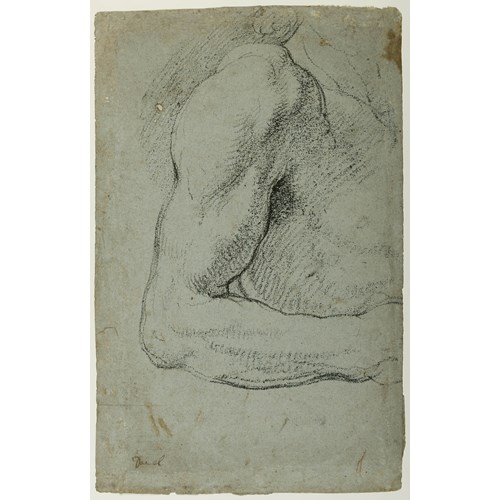ANTON RAPHAEL MENGS
Study for the Head of Mary Magdalene
Medium Oil on paper, laid down on board.Oil on paper, laid down on board
Dimension 38.6 x 30.5 cm (15¹/₄ x 12 inches)
Mengs worked on the large panel in a rented studio at the Villa Medici, where it was exhibited after its completion in September 1771, having earlier been shown to the Pope. As an English correspondent in Rome wrote, in a letter to the Warden of All Souls College, ‘The Picture is finish’d and I really think among the very best that ever I saw of his painting. In the Christ there is a great dignity and meekness, in the Magdalena the remains of Grief with a mixture of surprize and joy, is wonderfully express’d. The disposition of the Figures is very agreeable, the colouring strong and clear, but very harmonious and true…Those who have seen it admired it much.’ Similarly, a modern scholar has noted that ‘The painting is a very revealing example of Mengs’s eclectic approach, with borrowings from classical antiquity (the figure of Christ is deeply indebted to the Apollo Belvedere), and – in the loose and luminous landscape and in the general sweetness of expression – to Titian and Correggio.’
Although Mengs completed the actual painting of the altarpiece in around six weeks, he must have produced a number of preparatory studies and sketches for the picture beforehand. Preliminary chalk drawings for the figure and head of the Magdalene in the Noli me tangere altarpiece are today in the Prado in Madrid, the Albertina in Vienna and in a private collection in Malta. A similar oil sketch of this type, preparatory for the head of Christ in the painting, is in the Library at All Souls College in Oxford. As the Mengs scholar Steffi Roettgen has described that oil sketch, in terms equally applicable to this newly-rediscovered study for the head of the Magdalene in the same painting, ‘The fact that so carefully executed a head study was made to the same size as the picture throws a revealing light on the artist’s method of working. Mengs must have made an incredible number of drawings and oil studies for all his larger compositions...The study of the head differs only slightly from the finished painting. However, in expression, brushwork and liveliness it is superior.’
The head of the Magdalene in the All Souls Noli me tangere was much admired by some contemporary writers. As one young German scholar, on a visit to All Souls College in 1782, noted, ‘the chapel is particularly beautiful…over the altar here [is] a fine painting of Mengs…The painting represented Mary Magdalene when she first suddenly sees Jesus standing before her, and falls at His feet. And in her countenance pain, joy, grief, in short almost all of the strongest of our passions, are expressed in so masterly a manner, that no man of true taste was ever tired of contemplating it; the longer it is looked at the more it is admired.’
The first owner of this oil sketch was Meng’s son-in-law, the Spanish engraver Manuel Salvador Carmona (1734-1820), who married the painter’s daughter Anna Maria in 1778. This sketch is noted as being in Carmona’s collection in Madrid some ten years later, when it is mentioned by the 18th century Spanish painter Antonio Ponz in his magisterial book Viage de España, en que se da noticia de las cosas mas apreciables, y dignas de saberse, que hay en ella (Voyage Around Spain, In Which There is News of the Most Significant and Worthwhile Things in the Country), published in eighteen volumes between 1772 and 1794. The Viage de España was based on a trip Ponz made throughout Spain in 1771, during which he recorded all the notable works of art he saw. The present sheet is noted in the volume devoted to the region of Catalonia: ‘Don Manuel Salvador Carmona, Engraver of the Privy Chamber of His Majesty and son-in-law of Don Antonio Mengs, has different works of his. The paintings are a profile portrait of himself, a Head of the Magdalen... and some other small-scale paintings: different drawings on white and blue paper...’
422 x 337 mm. (16 5/8 x 13 1/4 in.) [board]
Medium: Oil on paper, laid down on board.Oil on paper, laid down on board
Dimension: 38.6 x 30.5 cm (15¹/₄ x 12 inches)
Provenance: The artist’s son-in-law, Manuel Salvador Carmona, Madrid
Acquired from him by Tomás de Veri y Togores, Palma de Mallorca, Mallorca
The Marqués de Ariany y de la Cenia, Mallorca
Thence by descent to the Cotoner collection, Marattxí, Mallorca, by 1920.
Literature: Antonio Ponz, Viage de España, Madrid, 1788, Vol.XIV, p.53, no.11; Tomás de Veri, Caudros notables de Mallorca. Principales colecciones de pinturas que existen en la Isla de Mallorca, Madrid, 1920, pl.XVI; Dieter Honisch, Anton Raphael Mengs und die Bildform des Frühklassizismus, Recklinghausen, 1965, p.131, no.304 and p.153, no.443; Steffi Roettgen, Anton Raphael Mengs 1728-1779 and his British Patrons, exhibition catalogue, London, 1993, p.108, under no.30; Steffi Roettgen, Anton Raphael Mengs 1729-1779, Munich, 1999, Vol.I (Das malerische und zeichnerische Werk), p.110, under no.66, and p.111, no.67.
More artworks from the Gallery








 Della Sudda, Seated at a Piano_T638203653503780352.jpg?width=500&height=500&mode=pad&scale=both&qlt=90&format=jpg)
_T638851411869690671.jpg?width=500&height=500&mode=pad&scale=both&qlt=90&format=jpg)